The Role of Cities: Linking Integrated Assessment Models to Urban Solutions
Abstract
:1. Introduction
2. Materials and Methods
2.1. Models Used to Project Impact Indicators for Sustainable Urban Solutions
2.1.1. Baseline Scenario (Business as Usual)
2.1.2. COP26 Scenario
2.2. Scoring and Ranking the Solutions of the OICS Platform
3. Results
3.1. Translating IAM’s Results into Indicators
3.1.1. The Role of Each Sector in Promoting Socioeconomic Growth
3.1.2. The Potential Contribution of OICS Solutions for Emission Reduction
3.2. Ranking the Top Solutions at the Urban Level
3.3. Ranking the Top Urban Solutions by Challenge
4. Discussion
4.1. Political Barriers to Implementing Solutions
4.2. What Local Governments Can Do
5. Conclusions
Author Contributions
Funding
Institutional Review Board Statement
Informed Consent Statement
Data Availability Statement
Acknowledgments
Conflicts of Interest
Appendix A
| Thematic Area | Solution Intervention Area | Corresponding Economic Sectors |
|---|---|---|
| Built Environment | Building materials | Extraction of iron ore; pig iron and iron alloys; cement |
| Building systems and technologies | Extraction of iron ore; pig iron and iron alloys; cement; construction | |
| Building design strategies and urban design | Construction; trade; feeding; accommodation; public and private education; public and private health; services of architecture, engineering, technical tests/analysis; other professional, scientific, and technical activities | |
| Design and evaluation methodologies and tools | Architectural and engineering services, technical tests/analysis; other professional, scientific, and technical activities | |
| Mobility | Electrification of mobility | Electrical energy; ground transport; water transport |
| Transport sharing systems | Electrical energy; ground transport; waterway transport; water transport; systems development; services of architecture, engineering, technical tests/analysis; other professional, scientific, and technical activities | |
| Methods, projects, plans, services, and mechanisms of sustainable urban mobility | Architectural and engineering services, technical tests/analysis; other professional, scientific, and technical activities | |
| Innovative urban mobility technologies | Ground transport; waterway transport; water transport; development of systems and other information services | |
| Sustainable mobility infrastructure | Construction; ground transport; water transport | |
| Vehicles powered by biofuels | Ground transport; waterway transport; manufacture of biofuels | |
| Energy | Renewable or distributed electricity generation | Electrical energy |
| Smart and innovative electricity systems | Electrical energy; water, sewage, and waste management | |
| Energy storage | Electrical energy; services of architecture, engineering, technical tests/analysis; other professional, scientific, and technical activities | |
| Energy management projects, mechanisms, and tools | Services of architecture, engineering, technical tests/analysis; other professional, scientific, and technical activities | |
| Biofuel production and carbon capture | Manufacture of biofuels | |
| Sanitation: Solid Waste | Energy use of waste | Refining oil and petrol coke; electricity, natural gas, and other utilities; water, sewage, and waste management |
| Conventional techniques for the collection, treatment, or disposal of solid waste | Water, sewage, and waste management; construction; ground transport; waterway transport; air transport | |
| Recycling, reuse, and reuse of waste | Manufacture of textile products; water, sewage, and waste management; construction; feeding | |
| Methods, tools, demand management and other sustainable waste management mechanisms | Services of architecture, engineering, technical tests/analysis; other professional, scientific, and technical activities | |
| Innovative technologies or processes for mitigating the disposal of solid waste | Water, sewage, and waste management; ground transport; waterway transport; air transport | |
| Sanitation: Water | Technologies that increase efficiency in water consumption in buildings | Manufacture of electrical machinery and equipment; water, sewage, and waste management |
| Conventional water treatment and reuse processes, systems, and techniques | Water, sewage, and waste management; services of architecture, engineering, technical tests/analysis; other professional, scientific, and technical activities | |
| Innovative techniques for water supply, treatment, reuse, and reuse | Manufacture of textile products; manufacture of rubber products and plastic material; manufacture of electrical machinery and equipment; water, sewage, and waste management | |
| Methods, tools, mechanisms, and management processes applied to the sanitation and supply chain | Services of architecture, engineering, technical tests/analysis; other professional, scientific, and technical activities; manufacture of electrical machinery and equipment; water, sewage, and waste management | |
| Techniques for removing plastic from water | Manufacture of rubber products and plastic material; water, sewage, and waste management | |
| Nature-based solutions | Techniques and processes applied to food production | Agriculture, forestry, forestry; livestock farming, including livestock support |
| Nature-based infrastructure | Agriculture, forestry, forestry; livestock farming, including livestock support; forest production; fisheries and aquaculture; construction; manufacture of wood products; production of pig iron/ferroalloys | |
| Conservation, monitoring, recovery and renaturalization of ecosystems and basins | Agriculture, forestry, forestry; livestock farming, including livestock support; forest production; fisheries and aquaculture; other professional, scientific, and technical activities | |
| Innovative technologies and techniques for the restoration of urban flora and fauna | Agriculture, forestry, forestry; livestock farming, including livestock support; forest production; fishing and aquaculture | |
| Nature-based methods, plans, services, and mechanisms | Services of architecture, engineering, technical tests/analysis; other professional, scientific, and technical activities |
References
- ONU. Nova Agenda Urbana: Declaração de Quito sobre Cidades e Assentamentos Humanos Sustentáveis para Todos em Conferência das Nações Unidas sobre Habitação e Desenvolvimento Urbano Sustentável (Habitat III) A Nova Agenda Urbana adotada na Conferência das Nações Unidas sobre Habitação e Desenvolvimento Urbano Sustentável (Habitat III), 20 de de Outubro de 2016, Quito (Equador). 2016. Available online: https://habitat3.org/wp-content/uploads/NUA-Portuguese-Brazil.pdf (accessed on 24 November 2022).
- IEA. Empowering Cities for a Net Zero Future, IEA, Paris. 2021. Available online: https://www.iea.org/reports/empowering-cities-for-a-net-zero-future (accessed on 24 November 2022).
- Van der Heijden, J. Studying urban climate governance: Where to begin, what to look for, and how to make a meaningful contribution to scholarship and practice. Earth Syst. Gov. 2019, 1, 100005. [Google Scholar] [CrossRef]
- IPCC. Summary for Policymakers. In Climate Change 2022: Impacts, Adaptation and Vulnerability; Pörtner, H.-O., Roberts, D.C., Poloczanska, E.S., Mintenbeck, K., Tignor, M., Alegría, A., Craig, M., Langsdorf, S., Löschke, S., Möller, V., et al., Eds.; Contribution of Working Group II to the Sixth Assessment Report of the Intergovernmental Panel on Climate Change; Cambridge University Press: Cambridge, UK; New York, NY, USA, 2022; pp. 3–33. [Google Scholar] [CrossRef]
- GCoM—Global Covenant of Mayors for Climate & Energy, 2022. The Largest Global Alliance for City Climate Leadership. Available online: https://www.globalcovenantofmayors.org/who-we-are/ (accessed on 24 November 2022).
- Huang, Y.; Tian, Z.; Ke, Q.; Liu, J.; Irannezhad, M.; Fan, D.; Hou, M.; Sun, L. Nature-based solutions for urban pluvial flood risk management. Wiley Interdiscip. Rev. Water 2020, 7, e1421. [Google Scholar] [CrossRef]
- Santamouris, M.; Kolokotsa, D. Urban Climate Mitigation Techniques; Routledge: Oxford, UK, 2016. [Google Scholar]
- Hammer, S.; Kamal-Chaoui, L.; Robert, A.; Plouin, M. Cities and Green Growth: A Conceptual Framework; OECD Regional Development Working Papers, No. 2011/08; OECD Publishing: Paris, France, 2011. [Google Scholar] [CrossRef]
- Miller, H.; Clifton, K.; Akar, G.; Tufte, K.; Gopalakrishnan, S.; MacArthur, J.; Irwin, E.; Ramnath, R.; Stiles, J. Urban Sustainability Observatories: Leveraging Urban Experimentation for Sustainability Science and Policy. Harv. Data Sci. Rev. 2021, 3, 2. [Google Scholar] [CrossRef]
- Sustainable Cities Programme (PCS). Sustainable Cities Platform. Available online: https://www.cidadessustentaveis.org.br/inicial/home (accessed on 14 November 2022).
- Center for Strategic Studies and Management (CGEE). Innovation Observatory for Sustainable Cities (OICS). Available online: https://oics.cgee.org.br/ (accessed on 14 November 2022).
- UN. A/RES/70/1—Transforming Our World: The 2030 Agenda for Sustainable Development. Seventieth United Nations General Assembly, New York. 2015. Available online: https://sdgs.un.org/2030agenda (accessed on 24 November 2022).
- Brasil. Ministério das Relações Exteriores. Apresentação da Contribuição Nacionalmente Determinada do Brasil perante o Acordo de Paris. 2022. Available online: https://unfccc.int/sites/default/files/NDC/2022-06/Updated%20-%20First%20NDC%20-%20%20FINAL%20-%20PDF.pdf (accessed on 14 November 2022).
- da Silva, F.T.; Szklo, A.; Vinhoza, A.; Nogueira, A.C.; Lucena, A.F.; Mendonça, A.M.; Marcolino, C.; Nunes, F.; Carvalho, F.M.; Tagomori, I.; et al. Inter-sectoral prioritization of climate technologies: Insights from a Technology Needs Assessment for mitigation in Brazil. Mitig. Adapt. Strateg. Glob. Chang. 2022, 27, 48. [Google Scholar] [CrossRef]
- Grubler, A.; Wilson, C.; Bento, N.; Boza-Kiss, B.; Krey, V.; Mccollum, D.L.; Rao, N.D.; Riahi, K.; Rogelj, J.; De Stercke, S.; et al. A low energy demand scenario for meeting the 1.5 °C target and sustainable development goals without negative emission technologies. Nat. Energy 2018, 3, 515–527. [Google Scholar] [CrossRef] [Green Version]
- Rogelj, J.; Shindell, D.; Jiang, K.; Fifita, S.; Forster, P.; Ginzburg, V.; Handa, C.; Kheshgi, H.; Kobayashi, S.; Kriegler, E.; et al. Global Warming of 1.5 °C. An IPCC Special Report on the impacts of global warming of 1.5 °C above pre-industrial levels and related global greenhouse gas emission pathways, in the context of strengthening the global response to the threat of climate change, sustainable development, and efforts to eradicate poverty. In Mitigation Pathways Compatible with 1.5 °C in the Context of Sustainable Developmen; IPCC/WMO: Geneva, Switzerland, 2018; pp. 93–174. [Google Scholar]
- Gambhir, A.; Drouet, L.; Mccollum, D.; Napp, T.; Bernie, D.; Hawkes, A.; Fricko, O.; Havlik, P.; Riahi, K.; Bosetti, V.; et al. Assessing the feasibility of global long-term mitigation scenarios. Energies 2017, 10, 89. [Google Scholar] [CrossRef] [Green Version]
- Cunha, B.S.; Garaffa, R.; Gurgel, Â.C. TEA Model Documentation. 2020. Available online: https://www.iamcdocumentation.eu/index.php/Model_Documentation_-_COFFEE-TEA (accessed on 18 February 2023).
- Rochedo, P.R.; Costa, I.V.; Império, M.; Hoffmann, B.S.; Merschmann, P.R.D.C.; Oliveira, C.C.; Szklo, A.; Schaeffer, R. Carbon capture potential and costs in Brazil. J. Clean. Prod. 2016, 131, 280–295. [Google Scholar] [CrossRef]
- Rochedo, P.R.R.; Soares-Filho, B.; Schaeffer, R.; Viola, E.; Szklo, A.; Lucena, A.F.P.; Koberle, A.; Davis, J.L.; Rajão, R.; Rathmann, R. The threat of political bargaining to climate mitigation in Brazil. Nat. Clim. Chang. 2018, 8, 695–698. [Google Scholar] [CrossRef]
- Köberle, A. Implementation of Land Use in an Energy System Model to Study the Long-Term Impacts of Bioenergy in Brazil and its Sensitivity to the Choice of Agricultural Greenhouse Gas Emission Factors. Ph.D. Thesis, Universidade Federal do Rio de Janeiro, Rio de Janeiro, Brazil, 2018. Available online: http://www.ppe.ufrj.br/index.php/pt/publicacoes/teses-e-dissertacoes/2018/130-implementation-of-land-use-in-an-energy-system-model-to-study-the-long-term-impacts-of-bioenergy-in-brazil-and-its-sensitivity-to-the-choice-of-agricultural-greenhouse-gas-emission-factors (accessed on 18 February 2023).
- Haddad, E.A.; Domingues, E.P. EFES-Um modelo aplicado de equilíbrio geral para a economia brasileira: Projeções setoriais para 1999–2004. Estud. Econômicos 2001, 31, 89–125. [Google Scholar]
- Horridge, M. The TERM Model and Its Data Base; Centre of Policy Studies—General Paper n. G-219; Centre of Policy Studies: Melbourne, Australia, 2011; p. 21. [Google Scholar]
- IBGE—Instituto Brasileiro de Geografia e Estatística. Coordenação de População e Indicadores Sociais. In Projeções da População: Brasil e Unidades da Federação: Revisão 2018; IBGE: Rio de Janeiro, Brazil, 2018. [Google Scholar]
- Altenburg, T.; Rodrik, D. Green Industrial Policy. Concept, Policies, Country Experiences; UN Environment; German Development Institute/Deutsches Institut für Entwicklungspolitk (DIE): Geneva, Bonn, 2017. [Google Scholar]
- UN Brazil. Transformando Nosso Mundo: A Agenda 2030 para o Desenvolvimento Sustentável. 2019. Available online: https://nacoesunidas.org/pos2015/agenda2030/ (accessed on 31 May 2019).
- SDG Strategy. SDGs Strategy. 2019. Available online: https://www.rbadvisors.no/sdg-strategy (accessed on 31 May 2019).
- OICS. Home—OICS. 2022. Available online: https://oics.cgee.org.br/solucoes-e-casos/solucoes (accessed on 18 February 2023).
- Fuhr, H.; Hickmann, T.; Kern, K. The role of cities in multi-level climate governance: Local climate policies and the 1.5 °C target. Curr. Opin. Environ. Sustain. 2018, 30, 1–6. [Google Scholar] [CrossRef]
- Gonzales-Iwanciw, J.; Dewulf, A.; Karlsson-Vinkhuyzen, S. Learning in multi-level governance of adaptation to climate change–a literature review. J. Environ. Plan. Manag. 2020, 63, 779–797. [Google Scholar] [CrossRef] [Green Version]
- Di Gregorio, M.; Fatorelli, L.; Paavola, J.; Locatelli, B.; Pramova, E.; Nurrochmat, D.R.; May, P.H.; Brockhaus, M.; Sari, I.M.; Kusumadewi, S.D. Multi-level governance and power in climate change policy networks. Glob. Environ. Chang. 2019, 54, 64–77. [Google Scholar] [CrossRef]
- Bulkeley, H.; Betsill, M. Rethinking Sustainable Cities: Multilevel Governance and the “Urban” Politics of Climate Change. Environ. Politics 2005, 14, 42–63. [Google Scholar] [CrossRef]
- Ryan, D. From commitment to action: A literature review on climate policy implementation at city level. Clim. Chang. 2015, 131, 519–529. [Google Scholar] [CrossRef]
- De Souza Leao, E.B.; Andrade, J.C.S.; Nascimento, L.F. Recife: A climate action profile. Cities 2021, 116, 103270. [Google Scholar] [CrossRef]
- Lo, K. Urban carbon governance and the transition toward low-carbon urbanism: Review of a global phenomenon. Carbon Manag. 2014, 5, 269–283. [Google Scholar] [CrossRef]
- Glazener, A.; Khreis, H. Transforming Our Cities: Best Practices Towards Clean Air and Active Transportation. Curr. Environ. Health Rep. 2019, 6, 22–37. [Google Scholar] [CrossRef]
- Santin, J.R.; Pedrini, M.; Comiran, R. The national solid waste policy and the brazilian municipalities: Challenges and possibilities/a politica nacional dos residuos solidos e os municipios brasileiros: Desafios e possibilidades. Direito da Cidade 2017, 9, 556–582. [Google Scholar]
- Singh, R.P.; Tyagi, V.V.; Allen, T.; Ibrahim, M.H.; Kothari, R. An overview for exploring the possibilities of energy generation from municipal solid waste (MSW) in Indian scenario. Renew. Sustain. Energy Rev. 2011, 15, 4797–4808. [Google Scholar] [CrossRef]
- Ershad Sarabi, S.; Han, Q.L.; Romme, A.G.; de Vries, B.; Wendling, L. Key Enablers of and Barriers to the Uptake and Implementation of Nature-Based Solutions in Urban Settings: A Review. Resources 2019, 8, 121. [Google Scholar] [CrossRef] [Green Version]
- Orner, K.D.; Mihelcic, J.R. A review of sanitation technologies to achieve multiple sustainable development goals that promote resource recovery. Environ. Sci. Water Res. Technol. 2017, 4, 16–32. [Google Scholar] [CrossRef]
- Lerebours, A.; Scott, R.; Sansom, K.; Kayaga, S. Regulating sanitation services in sub-saharan africa: An overview of the regulation of emptying and transport of faecal sludge in 20 cities and its implementation. Util. Policy 2021, 73, 101315. [Google Scholar] [CrossRef]
- O’brien, W.; Tahmasebi, F.; Andersen, R.K.; Azar, E.; Barthelmes, V.; Belafi, Z.D.; Berger, C.; Chen, D.; De Simone, M.; d’Oca, S.; et al. An international review of occupant-related aspects of building energy codes and standards. Build. Environ. 2020, 179, 106906. [Google Scholar] [CrossRef]
- Shen, Z.; Fitriaty, P. Overview: Green City Planning and Practices in Asian Cities. In Green City Planning and Practices in Asian Cities: Sustainable Development and Smart Growth in Urban Environments; Springer: Berlin/Heidelberg, Germany, 2018; pp. 1–16. [Google Scholar] [CrossRef]
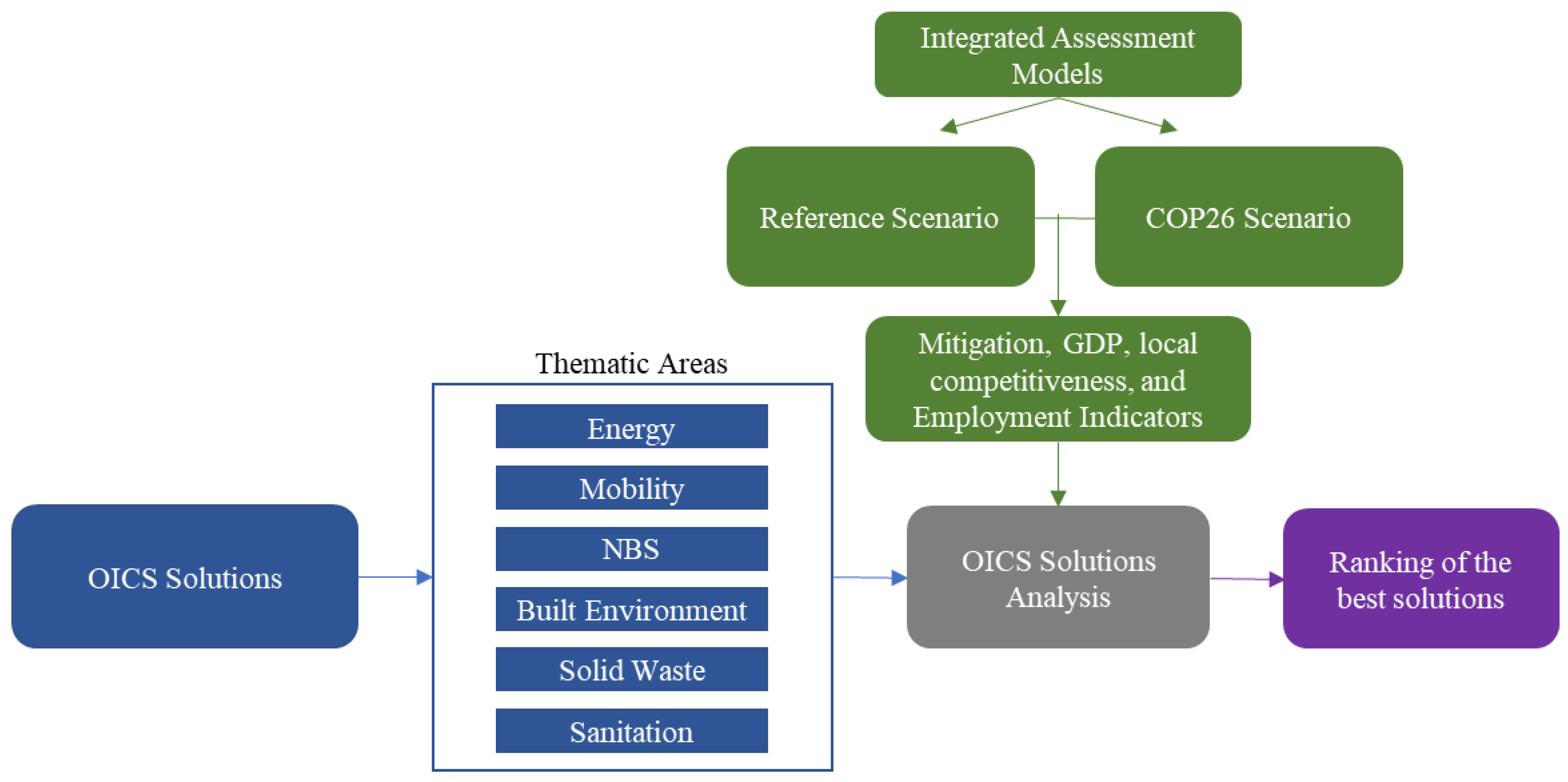
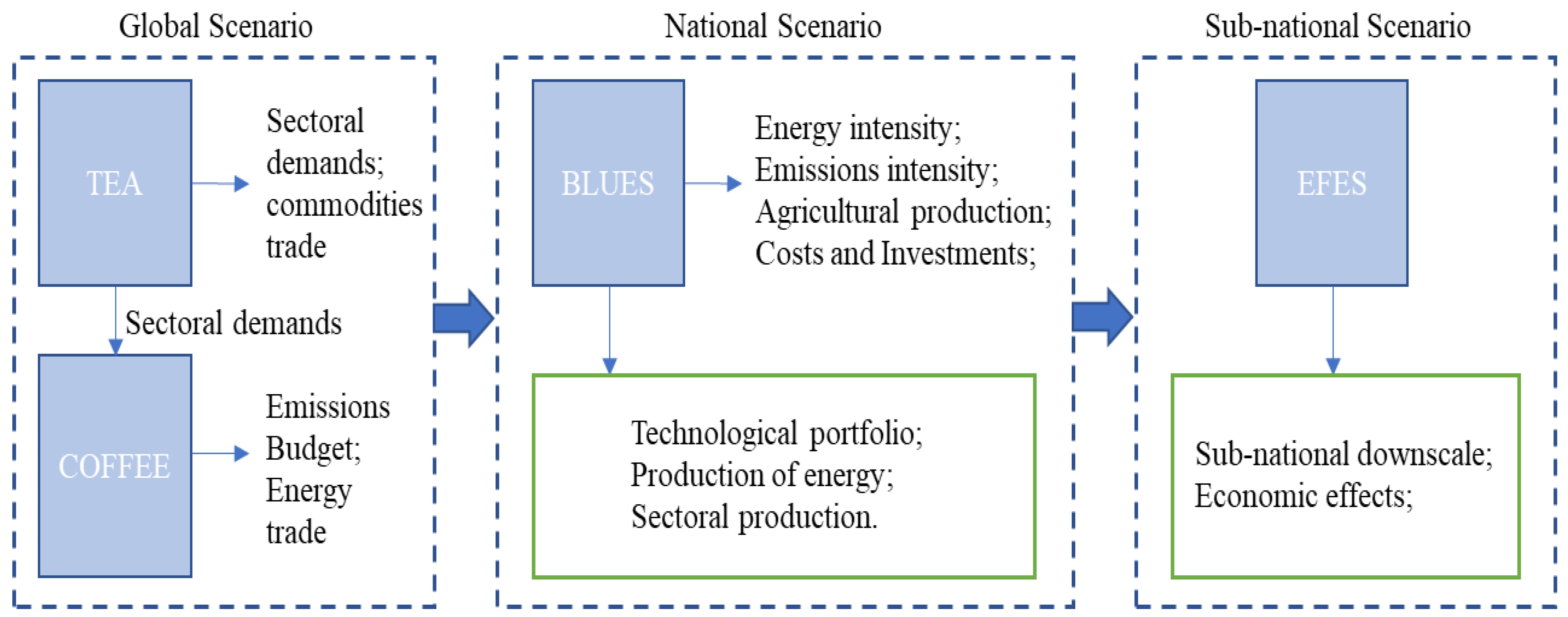
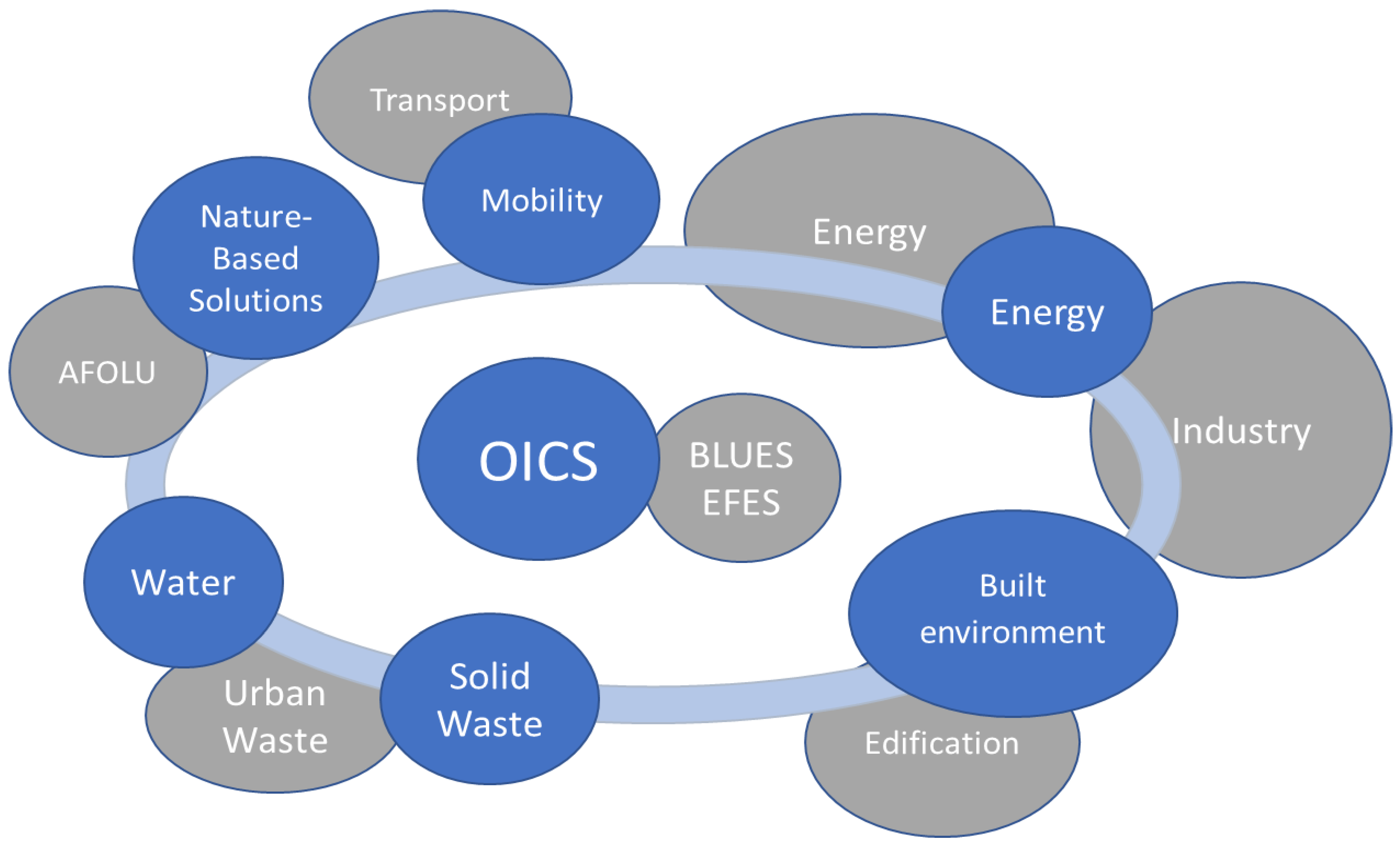
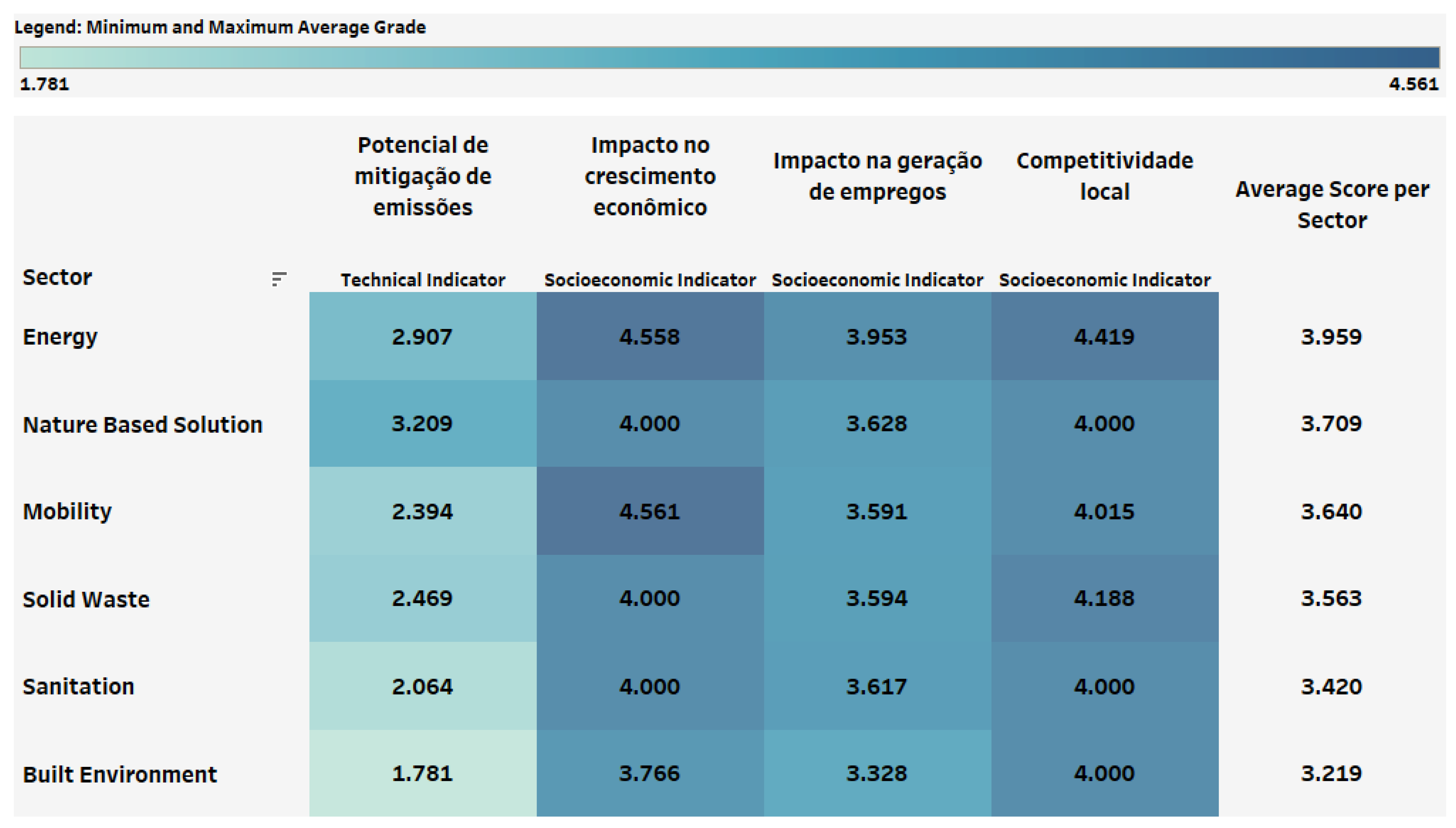
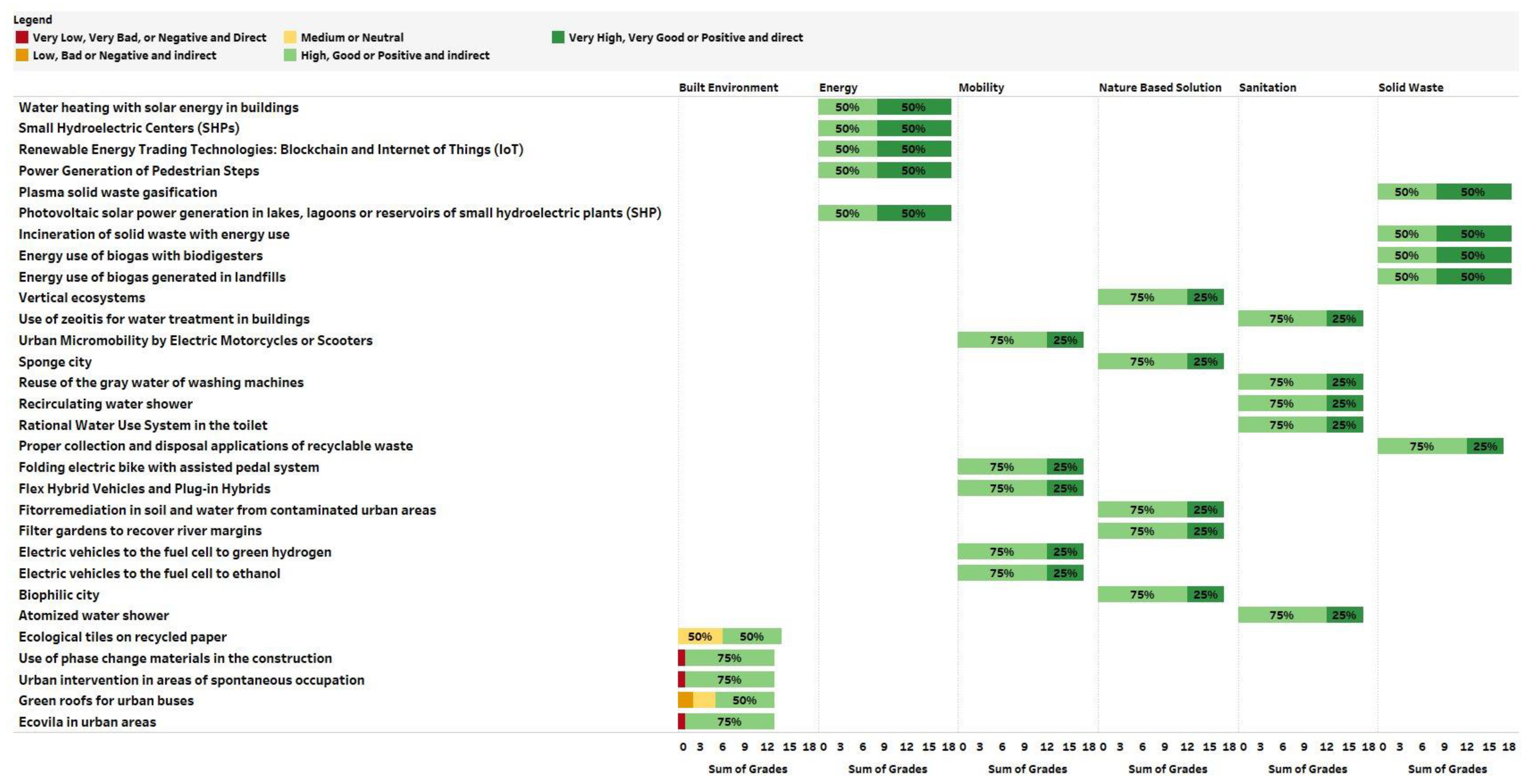
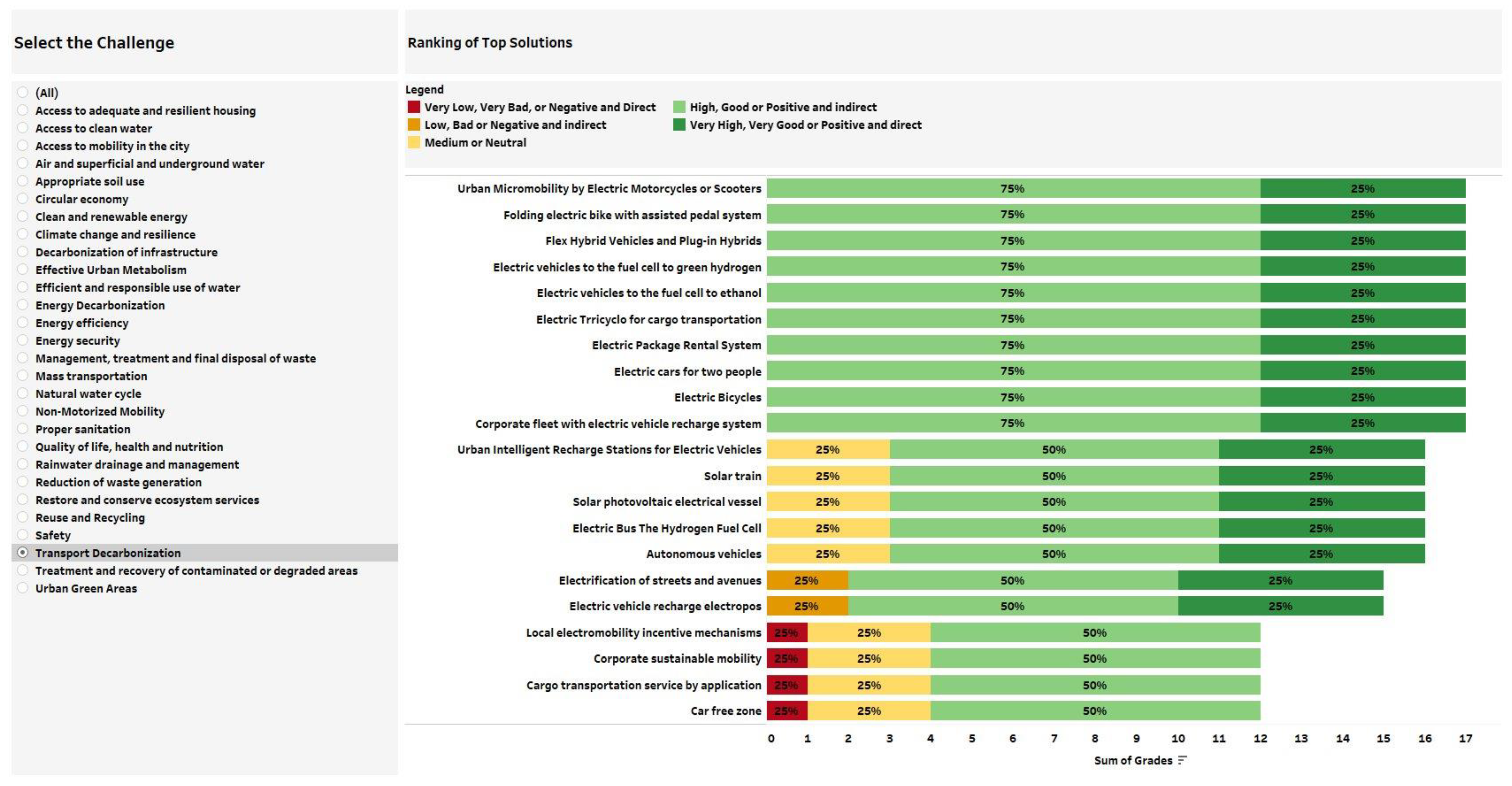
| Impact Class | GHG Emissions Mitigation Potential | Average Annual Variation in Jobs | Average Annual Variation in GDP | Average Annual Variation in Capital and Labor Productivity |
|---|---|---|---|---|
| 1 a | ≤5% | ≤−0.03% | ≤−0.04% | ≤−0.05% |
| 2 b | >5% ≤9% | >−0.03% ≤−0.02% | >−0.04% ≤−0.02% | >−0.05% ≤−0.02% |
| 3 c | >9% ≤14% | >−0.02% ≤0.01% | >−0.02% ≤0.01% | >−0.02% ≤0.01% |
| 4 d | >14% ≤19% | >0.01% ≤0.03% | >0.01% ≤0.04% | >0.01% ≤0.05% |
| 5 e | >19% | >0.03% | >0.04% | >0.05% |
| Thematic Area | Area of Intervention | Mitigation Potential | GDP (%) | Employment (%) | Competitiveness (%) |
|---|---|---|---|---|---|
| Built environment | Building materials | 11% | 0.01 | 0.01 | 0.02 |
| Building systems and technologies | 6% | 0.03 | 0.01 | 0.03 | |
| Building design strategies and urban design | 4% | 0.04 | 0.02 | 0.03 | |
| Design and evaluation methodologies and tools | 5% | 0.04 | 0.01 | 0.03 | |
| Mobility | Electromobility | 18% | 0.06 | 0.03 | 0.02 |
| Transport sharing systems | 17% | 0.05 | 0.02 | 0.02 | |
| Methods, projects, plans, services, and mechanisms of sustainable urban mobility | 5% | 0.03 | 0.01 | 0.02 | |
| Innovative urban mobility technologies | 10% | 0.05 | 0.02 | 0.03 | |
| Sustainable mobility infrastructure | 6% | 0.05 | 0.02 | 0.02 | |
| Vehicles powered by biofuel | 11% | 0.04 | 0.02 | 0.04 | |
| Energy | Distributed renewable electricity generation | 19% | 0.1 | 0.04 | 0.03 |
| Smart and innovative electricity systems | 44% | 0.06 | 0.03 | 0.03 | |
| Energy storage | 10% | 0.05 | 0.02 | 0.04 | |
| Energy management projects, mechanisms, and tools | 5% | 0.04 | 0.01 | 0.04 | |
| Biofuel production and carbon capture | 9% | 0.03 | 0.02 | 0.03 | |
| Solid waste | Energy use of waste | 53% | 0.03 | 0.02 | 0.04 |
| Conventional techniques for the collection, treatment, or disposal of solid waste | 15% | 0.04 | 0.02 | 0.03 | |
| Recycling, reuse, and the reuse of waste | 6% | 0.03 | 0.02 | 0.03 | |
| Methods, tools, demand management and other sustainable waste management mechanisms | 5% | 0.04 | 0.01 | 0.03 | |
| Innovative technologies or processes for mitigating the disposal of solid waste | 26% | 0.04 | 0.02 | 0.03 | |
| Sanitation | Technologies that improve water consumption efficiency in buildings | 29% | 0.03 | 0.02 | 0.02 |
| Conventional water treatment and reuse processes, systems, and techniques | 26% | 0.03 | 0.02 | 0.03 | |
| Innovative techniques for water supply, treatment, reuse, and reuse | 13% | 0.03 | 0.02 | 0.02 | |
| Methods, tools, mechanisms, and management processes applied to the sanitation and supply chain | 5% | 0.04 | 0.01 | 0.03 | |
| Techniques for removing plastic from water | 17% | 0.03 | 0.02 | 0.02 | |
| Nature-based solutions | Techniques and processes applied to food production | 17% | 0.03 | 0.01 | 0.02 |
| Nature-based infrastructure | 16% | 0.03 | 0.01 | 0.02 | |
| Conservation, monitoring, recovery and denaturalization of ecosystems and basins | 6% | 0.04 | 0.02 | 0.02 | |
| Innovative technologies and techniques for the restoration of urban flora and fauna | 18% | 0.04 | 0.02 | 0.02 | |
| Nature-based methods, plans, services, and mechanisms | 26% | 0.02 | 0.01 | 0.02 |
Disclaimer/Publisher’s Note: The statements, opinions and data contained in all publications are solely those of the individual author(s) and contributor(s) and not of MDPI and/or the editor(s). MDPI and/or the editor(s) disclaim responsibility for any injury to people or property resulting from any ideas, methods, instructions or products referred to in the content. |
© 2023 by the authors. Licensee MDPI, Basel, Switzerland. This article is an open access article distributed under the terms and conditions of the Creative Commons Attribution (CC BY) license (https://creativecommons.org/licenses/by/4.0/).
Share and Cite
Callegari, C.; Tanure, T.; Fiorini, A.C.O.; Haddad, E.; Domingues, E.; Magalhães, A.; Perobelli, F.; Porsse, A.; Lucena, A.F.P.; Vasquez-Arroyo, E.; et al. The Role of Cities: Linking Integrated Assessment Models to Urban Solutions. Sustainability 2023, 15, 4766. https://doi.org/10.3390/su15064766
Callegari C, Tanure T, Fiorini ACO, Haddad E, Domingues E, Magalhães A, Perobelli F, Porsse A, Lucena AFP, Vasquez-Arroyo E, et al. The Role of Cities: Linking Integrated Assessment Models to Urban Solutions. Sustainability. 2023; 15(6):4766. https://doi.org/10.3390/su15064766
Chicago/Turabian StyleCallegari, Camila, Tarik Tanure, Ana Carolina Oliveira Fiorini, Eduardo Haddad, Edson Domingues, Aline Magalhães, Fernando Perobelli, Alexandre Porsse, André F. P. Lucena, Eveline Vasquez-Arroyo, and et al. 2023. "The Role of Cities: Linking Integrated Assessment Models to Urban Solutions" Sustainability 15, no. 6: 4766. https://doi.org/10.3390/su15064766
APA StyleCallegari, C., Tanure, T., Fiorini, A. C. O., Haddad, E., Domingues, E., Magalhães, A., Perobelli, F., Porsse, A., Lucena, A. F. P., Vasquez-Arroyo, E., Império, M., Baptista, L. B., & Schaeffer, R. (2023). The Role of Cities: Linking Integrated Assessment Models to Urban Solutions. Sustainability, 15(6), 4766. https://doi.org/10.3390/su15064766






